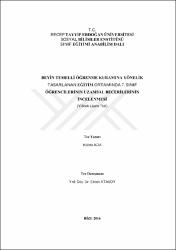Beyin temelli öğrenme kuramına yönelik tasarlanan eğitim ortamında 7. sınıf öğrencilerinin uzamsal becerilerinin incelenmesi
Özet
Çalışmanın amacı, Beyin Temelli Öğrenme (BTÖ) kuramına yönelik tasarlanan eğitim ortamında öğrencilerin uzamsal becerilerindeki gelişiminin incelenmesidir. Ayrıca araştırmanın kapsamında BTÖ kuramına ilişkin öğretmen ve öğrenci görüşlerine ulaşılması amaçlanmaktadır. Araştırmada nicel ve nitel araştırma tekniklerinden oluşan karma yöntem kullanılmıştır. Nicel bölümde ön test-son test kontrol gruplu deneysel araştırma modeli uygulanmıştır. Çalışmanın örneklemi ortaokul 7. sınıf öğrencilerinden oluşmaktadır. Deney grubuna BTÖ kuramına yönelik tasarlanan eğitim ortamında uygulama yapılırken; kontrol grubuyla mevcut matematik öğretim programına uyumlu ders işlenmiştir. Deney ve kontrol grubuna MGMP Uzamsal Yetenek Testi ön test-son test olarak uygulanmış, veriler SPSS 23 programında analiz edilmiştir. Ayrıca deney grubu öğrencilerinden mülakat grubu belirlenmiş, uygulama süreci öncesinde ve sonrasında uzamsal becerilere ilişkin dört açık uçlu soruyla görüşmeler yapılmıştır. Elde edilen verilerle öğrencilerin SOLO Taksonomisine göre gelişimi ayrıntılı olarak incelenmiştir. BTÖ kuramına ilişkin görüşlere ulaşabilmek amacıyla deney grubuna günlük tutturulmuş, uygulama sonunda mülakat grubu ve öğretmeniyle görüşmeler yapılmıştır. Elde edilen bulgular içerik analizi ve betimsel analiz yapılarak incelenmiştir. Çalışmanın sonunda deney grubu ve kontrol grubu öğrencilerinin uzamsal becerileri kıyaslandığında deney grubu lehine anlamlı bir farklılık olduğu belirlenmiştir. Ayrıca mülakat grubu öğrencilerinin uzamsal görselleştirme becerileri 'İlişkilendirilmiş Yapı' SOLO düzeyine kadar yükselirken; zihinsel döndürme becerilerindeki gelişimin aynı düzeyde gerçekleşmediği belirlenmiştir. Ayrıca öğrencilerin ve uygulama öğretmeninin BTÖ kuramına yönelik olumlu görüşlerine ulaşılmıştır. Anahtar kelimeler: Beyin Temelli Öğrenme, Uzamsal Beceri, SOLO Taksonomisi The aim of this study is investigation of students' spatial thinking ability in a learning environment designed according to BBL theory. Besides this, within the scope of this study, it is aimed to achieve teachers and students' opinions regarding to the learning environment of BBL theory. In this study, both quantitative and qualitative research techniques were used. In the quantitative part of the study, an experimental model control group with pre-test and post-test was applied. The sample consists of 7th grade students of the secondary educational school. In the learning environment, the experimental group was designed in accordance with and the lessons carried out based on BBL theory applications; while the control group was left with current mathematics curriculum course. For the experimental and control groups, the MGMP Spatial Abilithy Test, were applied with both pre-test and post-test, and the data were analyzed by SPSS23. Also, in the experimental students were defined interviewed groups, And intervies were complated with 4 open-ended questions regarding to their spatial skills and with before and after applications proces. The obtained data were discussed in details according to the students' structure of SOLO taxonomy. In order to achieve the perceptions about the BBL theory, diaries were kept by the experimental group. In addition to the students and the teachers were interviewed at the end of pratice. Results of this study; it was determined that there was a significant difference between the control group and experimental group, in favour of experimental group students compared with others. Experimental groupstudents applications were also been raised in the level of SOLO AS( Associated Structure), but it was determined that the mental rotation ability was not developed as the same level of realization. Students and teachers also reached a positive opinion on the BBL theory. Keywords : Brain-Based Learning, Spatial Skills, Solo Taxonomy


















